|
Dalmatia
Dalmatia (/dælˈmeɪʃə, -tiə/; Croatian: Dalmacija [dǎlmatsija]; Italian: Dalmazia [dalˈmattsja]; see names in other languages) is one of the four historical regions of Croatia,[1][4] alongside Central Croatia, Slavonia, and Istria, located on the east shore of the Adriatic Sea in Croatia. Dalmatia is a narrow belt stretching from the island of Rab in the north to the Bay of Kotor in the south. The Dalmatian Hinterland ranges in width from fifty kilometres in the north, to just a few kilometres in the south; it is mostly covered by the rugged Dinaric Alps. Seventy-nine islands (and about 500 islets) run parallel to the coast, the largest (in Dalmatia) being Brač, Pag, and Hvar. The largest city is Split, followed by Zadar, Šibenik, and Dubrovnik. The name of the region stems from an Illyrian tribe called the Dalmatae, who lived in the area in classical antiquity. Later it became a Roman province (with much larger territory than modern region), and as result a Romance culture emerged, along with the now-extinct Dalmatian language, later largely replaced with related Venetian and Italian, which were mainly spoken by the Dalmatian Italians. With the arrival of the Sclaveni (South Slavs) to the area in the late 6th and early 7th century, who eventually occupied most of the coast and hinterland, Slavic and Romance elements began to intermix in language and culture. After the medieval Kingdom of Croatia, in which most of Dalmatia resided, entered a personal union with Hungary in 1102, its cities and lands were often conquered by, or switched allegiance to, the kingdoms of the region during the Middle Ages. At one time, most of Dalmatia came under rule of the Republic of Venice, which controlled most of Dalmatia between 1420 and 1797 as part of its State of the Sea, with the exception of the small but stable Republic of Ragusa (1358–1808) in the south. Between 1815 and 1918, it was a province of the Austrian Empire known as the Kingdom of Dalmatia. After the Austro-Hungarian defeat in World War I, Dalmatia was split between the Kingdom of Serbs, Croats and Slovenes, which controlled most of it, and the Kingdom of Italy, which held several smaller parts. After World War II, the People's Republic of Croatia as a part of Yugoslavia took complete control over the area. Following the dissolution of Yugoslavia, Dalmatia became part of the Republic of Croatia. Definition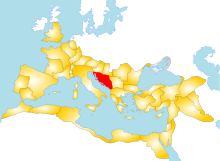 In antiquity, the Roman province of Dalmatia was much larger than the present-day Split-Dalmatia County, stretching from Istria in the north to modern-day Albania in the south.[5] Dalmatia signified not only a geographical unit, but was an entity based on common culture and settlement types, a common narrow eastern Adriatic coastal belt, Mediterranean climate, sclerophyllous vegetation of the Illyrian province and Adriatic carbonate platform Modern area Today, Dalmatia is a historical region only, not formally instituted in Croatian law. Its exact extent is therefore uncertain and subject to public perception. According to Lena Mirošević and Josip Faričić of the University of Zadar:[6]
"Dalmatia" is therefore generally perceived to extend approximately to the borders of the Austrian Kingdom of Dalmatia. However, due to territorial and administrative changes over the past century, the perception can be seen to have altered somewhat with regard to certain areas, and sources conflict as to their being part of the region in modern times:
Etymology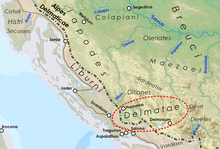 The regional name Dalmatia originates from Dalmatae, the name of the Illyrian, Balkan tribe who were the original inhabitants of the region, and from which the later toponym, Delminium, is derived.[16][17][18] It is considered by some to be connected to the Albanian dele and its variants which include the Gheg form delmë, meaning "sheep", and to the Albanian term delmer, "shepherd",[19][20][21][22][23][24] although there is lack of compelling evidence in ancient literary sources that Delmatae is derived from a word meaning "sheep".[25] According to Vladimir Orel, the Gheg form delmë hardly has anything in common with the name of Dalmatia because it represents a variant of dele with *-mā, which is ultimately from proto-Albanian *dailā.[26] The ancient name Dalmana, derived from the same root, testifies to the advance of the Illyrians into the middle Vardar, between the ancient towns of Bylazora and Stobi.[24] The medieval Slavic toponym Ovče Pole ("plain of sheep" in South Slavic) in the nearby region represents a related later development.[24] According to István Schütz, in Albania, Delvinë represents a toponym linked to the root *dele.[22] The form of the regional name Dalmatia and the respective tribal name Dalmatae are later variants as is already noted by Appian (2nd century AD). His contemporary grammarian Velius Longus highlights in his treatise about orthography that the correct form of Dalmatia is Delmatia, and notes that Marcus Terentius Varro who lived about two centuries prior to Appian and Velius Longius, used the form Delmatia as it corresponded to the chief settlement of the tribe, Delminium.[27] The toponym Duvno is a derivation from Delminium in Croatian via an intermediate form *Delminio in late antiquity.[18] Its Latin form Dalmatia gave rise to its current English name. In the Venetian language, once dominant in the area, it is spelled Dalmàssia, and in modern Italian Dalmazia. The modern Croatian spelling is Dalmacija, and the modern Serbian Cyrillic spelling is Далмација (pronounced [dǎlmaːt͡sija]). HistoryAntiquity Dalmatia's name is derived from the name of an Illyrian tribe called the Dalmatae who lived in the area of the eastern Adriatic coast in the 1st millennium BC. It was part of the Illyrian Kingdom between the 4th century BC and the Illyrian Wars (220, 168 BC) when the Roman Republic established its protectorate south of the river Neretva. The name "Dalmatia" was in use probably from the second half of the 2nd century BC and certainly from the first half of the 1st century BC, defining a coastal area of the eastern Adriatic between the Krka and Neretva rivers.[28] It was slowly incorporated into Roman possessions until the Roman province of Illyricum was formally established around 32–27 BC. In 9 AD, the Dalmatians raised the last in a series of revolts[29] together with the Pannonians, but it was finally crushed and, in 10 AD, Illyricum was split into two provinces, Pannonia and Dalmatia, which spread into larger area inland to cover all of the Dinaric Alps and most of the eastern Adriatic coast.[30] The historian Theodor Mommsen wrote in his book, The Provinces of the Roman Empire, that all Dalmatia was fully romanized by the 4th century AD. However, analysis of archaeological material from that period has shown that the process of Romanization was rather selective. While urban centers, both coastal and inland, were almost completely romanized, the situation in the countryside was completely different. Despite the Illyrians being subject to a strong process of acculturation, they continued to speak their native language, worship their own gods and traditions, and follow their own social-political tribal organization which was adapted to Roman administration and political structure only in some necessities.[31] The fall of the Western Roman Empire, with the beginning of the Migration Period, left the region subject to Gothic rulers Odoacer and Theodoric the Great. They ruled Dalmatia from 480 to 535 AD, when it was restored to the Eastern Roman (Byzantine) Empire by Justinian I. Middle Ages   In the Early Middle Ages, the territory of the Byzantine province of Dalmatia reached in the North up to the river Sava, and was part of the Praetorian prefecture of Illyricum. In the middle of the 6th and the beginning of the 7th century began the Slavic migration, which caused the Romance-speaking population, descendants of Romans and Illyrians (speaking Dalmatian), to flee to the coast and islands.[32] The hinterland, semi-depopulated by the Barbarian Invasions, Slavic tribes settled. The Slavs alongside Avars by 619 brought to ruin the capital Salona (an event that allowed for the settlement of the nearby Diocletian's Palace in Spalatum), Asseria, Varvaria, Burnum, Scardona, Epidaurum and Acruvium (resulting with the foundation of Kotor), and Epidaurum (resulting with the foundation of Ragusa).[33] The arrived tribes of Croats, Serbs and other Slavs founded sclaviniae Croatia, Pagania, Zachlumia, Travunia and Konavle (also small region of Bosnia, with Duklja in near Praevalitana and Serbia in Dalmatia, Praevalitana and Moesia).[34] In the early 9th century, the Eastern Adriatic coast including Dalmatia was the scene of the sphere of influence struggle between the Frankish and Byzantine Empire, but although the Byzantines have retained supremacy, Dalmatia became a meeting place between the West and the East.[35] The meaning of the administrative-geographical term "Dalmatia" by 820 shrank to the coastal cities and their immediate hinterland - Byzantine theme of Dalmatia.[36] Its cities were the Romance-speaking Dalmatian city-states and remained influential as they were well fortified and maintained their connection with the Byzantine Empire. The original name of the cities was Jadera (Zadar; capital of the theme), Spalatum (Split), Crepsa (Cres), Arba (Rab), Tragurium (Trogir), Vecla (Krk), Ragusium (Dubrovnik) and Cattarum (Kotor).[36] The language and the laws were initially Latin, but after a few centuries they developed their own neo-Latin language (the "Dalmatico"), that lasted until the 19th century.[37] The cities were maritime centres with a huge commerce mainly with the Italian peninsula and with the growing Republic of Venice.[36] The Latin and Slavic communities were somewhat hostile at first, but as the Croats became Christianized this tension increasingly subsided. A degree of cultural mingling soon took place, in some enclaves stronger, in others weaker, as Slavic influence and culture was more accentuated in Ragusa, Spalatum, and Tragurium. In the first half of the 10th century, Croatia was elevated to a kingdom by Duke Tomislav who also extended his influence further southwards to Zachlumia. As an ally of the Byzantine Empire, the King was given the status of Protector of Dalmatia, and became its de facto ruler. In the subsequent period, the rulers of Croatia exerted influence over Dalmatian cities and islands, occasionally taking control such as the conquest of Zadar in the mid-11th century. Chronicler Thomas the Archdeacon relates that Stephen Držislav took the title "King of Dalmatia and Croatia", and that all subsequent rulers styled themselves in such manner. Petar Krešimir IV of Croatia expanded his rule to permanently incorporate Dalmatian cities and islands by 1069. Upon the death of King Demetrius Zvonimir of Croatia by the end of 1080s, the state entered a period of anarchy and would result in Hungarians under Coloman of Hungary taking control over former Dalmatian possessions along with the rest of the state by 1102. In the High Medieval period, the Byzantine Empire was no longer able to expand its power consistently in Dalmatia, and was finally rendered impotent so far west by the Fourth Crusade in 1204. The Republic of Venice, on the other hand, was in the ascendant, while the Croatia became increasingly influenced by Hungary to the north, being absorbed into it via personal union in 1102. Thus, these two factions became involved in a struggle in this area, intermittently controlling it as the balance shifted. During the reign of King Emeric, the Dalmatian cities separated from Hungary by a treaty.[38] A consistent period of Hungarian rule in Dalmatia was ended with the Mongol invasion of Hungary in 1241. The Mongols severely impaired the feudal state, so much so that that same year, King Béla IV had to take refuge in Dalmatia, as far south as the Fortress of Klis. The Mongols attacked the Dalmatian cities for the next few years but eventually withdrew without major success. At the beginning of the 14th century and until 1322, the Dalmatian cities were under the control of the noble Šubić family which held them until they were defeated at the Battle of Bliska by a coalition of nobles, Dalmatian cities and royal troops loyal to Charles I of Hungary. In the south, due to its protected location, Kotor became a major city for the salt trade. The area was prosperous during the 14th century under the rule of Emperor of the Serbs Dušan the Mighty, who encouraged law enforcement, which helped the Bay of Kotor to become a safe place for doing business.[39] In 1389, Tvrtko I, the founder of the Kingdom of Bosnia, was able to control the Adriatic littoral between Kotor and Šibenik, and even claimed control over the northern coast up to Rijeka, and his own independent ally, Republic of Ragusa. This was only temporary, as Hungary and the Venetians continued their struggle over Dalmatia after Tvrtko's death in 1391. By this time, the whole Hungarian and Croatian Kingdom was facing increasing internal difficulties, as a 20-year civil war ensued between the Capetian House of Anjou from the Kingdom of Naples, and King Sigismund of the House of Luxembourg. During the war, the losing contender, Ladislaus of Naples, sold his "rights" on Dalmatia to the Republic of Venice for a mere 100,000 ducats. The much more centralized Republic came to control the coast and near hinterland of Dalmatia by the year 1420, it was to remain under Venetian rule for 377 years (1420–1797).[40] Early modern period 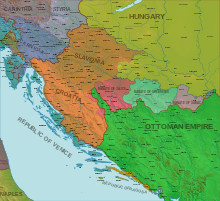    Dalmatia was first and finally sold to the Republic of Venice in 1409 but Venetian Dalmatia was not fully consolidated from 1420.[41] The Republic of Venice in 1420 controlled coastal part of Dalmatia, with the southern enclave, the Bay of Kotor, being called Venetian Albania. Venetian was the commercial lingua franca in the Mediterranean at that time, and it heavily influenced Dalmatian and to a lesser degree coastal Croatian and Albanian. The southern city of Ragusa (Dubrovnik) became de facto independent in 1358 through the Treaty of Zadar when Venice relinquished its suzerainty over it to Louis I of Hungary. In 1481, Ragusa switched allegiance to the Ottoman Empire. This gave its tradesmen advantages such as access to the Black Sea, and the Republic of Ragusa was the fiercest competitor to Venice's merchants in the 15th and 16th centuries. Originally, Latin was used in official documents of the Republic. Italian came into use in the 1420s. Both languages were used in official correspondence by the Republic. The Republic was influenced by the Venetian language and the Tuscan dialect. In the early 16th century, most of the Dalmatian hinterland which was controlled by the Hungarian-Croatian Kingdom was lost to the Ottoman Empire by the 1520s when was formed Croatian vilayet which became incorporated into the Sanjak of Klis after the Siege of Klis (1537),[42] and decades later into the Bosnia Eyalet.[43] With the fall of the Hungarian-Venetian border in Dalmatia, Venetian Dalmatia now directly bordered with the Ottoman Dalmatia. Venetians still perceived this inner hinterland as once part of Croatia, calling it as "Banadego" (lands of Ban i.e. Banate).[44] The Republic of Venice was also one of the powers most hostile to the Ottoman Empire's expansion, and participated in many wars against it, but also promoted peace negotiations and cultural and religious coexistence and tolerance.[45] Since the 16th century Slavicized Vlachs, Serbs and other South Slavs arrived both as martolos in Ottoman service and refugees fleeing from Ottoman territory to the Military Frontier and Venetian Dalmatia.[46][47] As the Ottomans took control of the hinterland, many Christians took refuge in the coastal cities of Dalmatia. In the Ottoman Dalmatia many people converted to Islam to get freedom and privileges.[48] The border between the Dalmatian hinterland and the Ottoman Bosnia and Herzegovina greatly fluctuated until the Morean War, when the Venetian capture of Knin and Sinj set much of the borderline at its current position.[49] 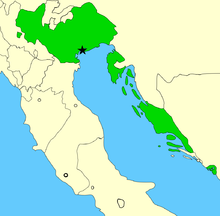 After the Great Turkish War and the Treaty of Passarowitz, more peaceful times made Dalmatia experience a period of certain economic and cultural growth in the 18th century, with the re-establishment of trade and exchange with the hinterland. This period was abruptly interrupted with the fall of the Republic of Venice in 1797. Napoleon's troops stormed the region and ended the independence of the Republic of Ragusa as well, saving it from occupation by the Russian Empire and Montenegro. In 1805, Napoleon created his Kingdom of Italy around the Adriatic Sea, annexing to it the former Venetian Dalmatia from Istria to Kotor. In 1808, he annexed the just conquered Republic of Ragusa to the Kingdom. A year later, in 1809, he removed the Venetian Dalmatia from his Kingdom of Italy and created the Illyrian Provinces, which were annexed to France, and named Marshal General Jean-de-Dieu Soult the Duke of Dalmatia. Napoleon's rule in Dalmatia was marked with war and high taxation, which caused several rebellions. On the other hand, French rule greatly contributed to Croatian national revival (the first newspaper in Croatian was published then in Zadar, Il Regio Dalmata – Kraglski Dalmatin), the legal system and infrastructure were finally modernized somewhat in Dalmatia, and the educational system flourished. French rule brought a lot of improvements in infrastructure; many roads were built or reconstructed. Napoleon himself blamed Marshal of the Empire Auguste de Marmont, the governor of Dalmatia, that too much money was spent. However, in 1813, the Habsburgs once again declared war on France and, by the following year, had restored control over Dalmatia. From the Middle Ages to the 19th century, Italian and Slavic communities in Dalmatia had lived peacefully side by side because they did not know the national identification, given that they generically defined themselves as "Dalmatians", of "Romance" or "Slavic" culture.[50] 19th century At the Congress of Vienna in 1815, Dalmatia was granted as a province to the Emperor of Austria. It was officially known as the Kingdom of Dalmatia. From the Middle Ages to the 19th century, Italian and Slavic communities in Dalmatia had lived peacefully side by side because they did not know the national identification, given that they generically defined themselves as "Dalmatians", of "Romance" or "Slavic" culture.[51] In 1848, the Croatian Parliament (Sabor) published the People's Requests, in which they requested among other things the abolition of serfdom and the unification of Dalmatia and Croatia. The Dubrovnik municipality was the most outspoken of all the Dalmatian communes in its support for unification with Croatia. A letter was sent from Dubrovnik to Zagreb with pledges to work for this idea. In 1849, Dubrovnik continued to lead the Dalmatian cities in the struggle for unification. A large-scale campaign was launched in the Dubrovnik paper L'Avvenire (The Future) based on a clearly formulated programme: the federal system for the Habsburg territories, the inclusion of Dalmatia into Croatia and the Slavic brotherhood. The President of the Council of Kingdom of Dalmatia was Baron Vlaho Getaldić. In the same year, the first issue of the Dubrovnik almanac appeared, Flower of the National Literature (Dubrovnik, cvijet narodnog književstva), in which Petar Preradović published his noted poem "Pjesma Dubrovniku" (Poem to Dubrovnik). This and other literary and journalistic texts, which continued to be published, contributed to the awakening of the national consciousness reflected in efforts to introduce the Croatian language into schools and offices, and to promote Croatian books. The Emperor Franz Joseph brought the March Constitution which prohibited the unification of Dalmatia and Croatia and also any further political activity with this end in view. The political struggle of Dubrovnik to be united with Croatia, which was intense throughout 1848–49, did not succeed at that time. Many Dalmatian Italians looked with sympathy towards the Risorgimento movement that fought for the unification of Italy. However, after 1866, when the Veneto and Friuli regions were ceded by the Austrians to the newly formed Kingdom Italy, Dalmatia remained part of the Austro-Hungarian Empire, together with other Italian-speaking areas on the eastern Adriatic. This triggered the gradual rise of Italian irredentism among many Italians in Dalmatia, who demanded the unification of the Austrian Littoral, Fiume and Dalmatia with Italy. The Italians in Dalmatia supported the Italian Risorgimento: as a consequence, the Austrians saw the Italians as enemies and favored the Slav communities of Dalmatia.  During the meeting of the Council of Ministers of 12 November 1866, Emperor Franz Joseph I of Austria outlined a wide-ranging project aimed at the Germanization or Slavization of the areas of the empire with an Italian presence:[52]
Dalmatia, especially its maritime cities, once had a substantial local ethnic Italian population (Dalmatian Italians), making up 33% of the total population of Dalmatia in 1803,[54][55] but this was reduced to 20% in 1816.[56] According to Austrian censuses, the Dalmatian Italians formed 12.5% of the population in 1865,[57] but this was reduced to 2.8% in 1910.[58] In Dalmatia there was a constant decline in the Italian population, in a context of repression that also took on violent connotations.[59] The Italian population in Dalmatia was concentrated in the major coastal cities. In the city of Split in 1890 there were 1,969 Dalmatian Italians (12.5% of the population), in Zadar 7,423 (64.6%), in Šibenik 1,018 (14.5%), in Kotor 623 (18.7%) and in Dubrovnik 331 (4.6%).[60] In other Dalmatian localities, according to Austrian censuses, Dalmatian Italians experienced a sudden decrease: in the twenty years 1890-1910, in Rab they went from 225 to 151, in Vis from 352 to 92, in Pag from 787 to 23, completely disappearing in almost all the inland locations. While Slavic-speakers made up 80-95% of the Dalmatia populace,[61] only Italian language schools existed until 1848,[62] and due to restrictive voting laws, the Italian-speaking aristocratic minority retained political control of Dalmatia.[63] Only after Austria liberalized elections in 1870, allowing more majority Slavs to vote, did Croatian parties gain control. Croatian finally became an official language in Dalmatia in 1883, along with Italian.[64] Yet minority Italian-speakers continued to wield strong influence, since Austria favored Italians for government work, thus in the Austrian capital of Dalmatia, Zara, the proportion of Italians continued to grow, making it the only Dalmatian city with an Italian majority.[65] In 1861 was the meeting of the first Dalmatian Assembly, with representatives from Dubrovnik. Representatives of Kotor came to Dubrovnik to join the struggle for unification with Croatia. The citizens of Dubrovnik gave them a festive welcome, flying Croatian flags from the ramparts and exhibiting the slogan Ragusa with Kotor. The Kotorans elected a delegation to go to Vienna; Dubrovnik nominated Niko Pucić, who went to Vienna to demand not only the unification of Dalmatia with Croatia, but also the unification of all Croatian territories under one common Sabor. During this period, the Habsburgs carried out an aggressive anti-Italian policy through a forced Slavization of the region.[66] 20th century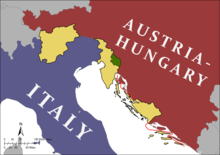 In 1905, a dispute arose in the Austrian Imperial Council over whether Austria should pay for Dalmatia. It has been argued that in the conclusion of the April Laws is written "given by Banus Count Keglevich of Bužim", which explained the historical affiliation of Dalmatia to Hungary.[67] Two years later Dalmatia elected representatives to the Austrian Imperial Council. Until 1909, both Italian and Croatian were recognized as official languages in Dalmatia. After 1909, Italian lost its official status, thus it could no longer be used in the public and administrative sphere.[68] Dalmatia was a strategic region during World War I that both Italy and Serbia intended to seize from Austria-Hungary. Italy joined the Triple Entente Allies in 1915 upon agreeing to the Treaty of London that guaranteed Italy the right to annex a large portion of Dalmatia in exchange for Italy's participation on the Allied side. From 5–6 November 1918, Italian forces were reported to have reached Vis, Lastovo, Šibenik, and other localities on the Dalmatian coast.[69] By the end of hostilities in November 1918, the Italian military had seized control of the entire portion of Dalmatia that had been guaranteed to Italy by the Treaty of London and by 17 November had seized Rijeka as well creating the first Governorate of Dalmatia.[70] In 1918, Admiral Enrico Millo declared himself Italy's Governor of Dalmatia.[70] Famous Italian nationalist Gabriele D'Annunzio supported the seizure of Dalmatia, and proceeded to Zadar in an Italian warship in December 1918.[71] However, in spite of the guarantees of the Treaty of London to Italy of a large portion of Dalmatia and Italian military occupation of claimed territories of Dalmatia, during the peace settlement negotiations of 1919 to 1920, the Fourteen Points of Woodrow Wilson that advocated self-determination of nations took precedence, with Italy only being permitted to annex Zadar from Dalmatia, while the rest of Dalmatia was to be part of Yugoslavia.  At the end of World War I, the Austrian Empire disintegrated, and Dalmatia was again split between the Kingdom of Serbs, Croats and Slovenes (later the Kingdom of Yugoslavia) which controlled most of it, and the Kingdom of Italy which held small portions of northern Dalmatia around Zadar and the islands of Cres, Lošinj, and Lastovo. Italy entered World War I in a territorial gamble, mostly to gain Dalmatia. But Italy got only a small part of its pretensions, so Dalmatia mostly stayed Yugoslav. Despite the fact that there were only a few thousand Italian-speakers in Dalmatia[72] after the constant decrease that occurred in previous decades, Italian irredentists continued to lay claim to all of Dalmatia. In 1927 Italy signed an agreement with the Croatian fascist, terrorist Ustaše organization. The Ustaše agreed that once they gained power, they will cede to Italy additional territory in Dalmatia and the Bay of Kotor, while renouncing all Croatian claims to Istria, Rijeka, Zadar and the Adriatic Islands.[73] 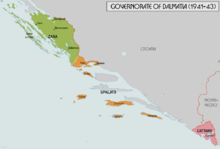  In 1922, the territory of the former Kingdom of Dalmatia was divided into two provinces, the Oblast of Split and the Oblast of Dubrovnik. In 1929, the Littoral Banovina, a province of the Kingdom of Yugoslavia, was formed. Its capital was Split, and it included most of Dalmatia and parts of present-day Bosnia and Herzegovina. The southern parts of Dalmatia were in Zeta Banovina, from the Bay of Kotor to Pelješac peninsula including Dubrovnik. In 1939, Littoral Banovina was joined with Sava Banovina (and with smaller parts of other banovinas) to form a new province named the Banovina of Croatia. The same year, the ethnic Croatian areas of the Zeta Banovina from the Bay of Kotor to Pelješac, including Dubrovnik, were merged with a new Banovina of Croatia. During World War II, in 1941, Nazi Germany, Fascist Italy, Hungary, and Bulgaria occupied Yugoslavia, redrawing their borders to include former parts of the Yugoslavian state. A new Nazi puppet state, the Independent State of Croatia (NDH), was created. With the Treaties of Rome, the NDH agreed to cede to Italy Dalmatian territory, creating the second Governorate of Dalmatia, from north of Zadar to south of Split, with inland areas, plus nearly all the Adriatic islands and Gorski Kotar. Italy then annexed these territories, while all the remainder of southern Croatia, including the entire coast, were placed under Italian occupation. Italy also appointed an Italian, Prince Aimone, Duke of Aosta, as king of Croatia.[74] Italy proceeded to Italianize the annexed areas of Dalmatia.[75] Place names were Italianized, and Italian was made the official language in all schools, churches and government administration.[75] All Croatian cultural societies were banned, while Italians took control of all key mineral, industrial and business establishments.[75] Italian policies prompted resistance by Dalmatians, many joined the Partisans.[76] This led to further Italian repressive measures - shooting of civilian hostages, burning of villages, confiscation of properties. Italians took many civilians to concentration camps[76] - altogether, some 80,000 Dalmatians, 12% of the population, passed through Italian concentration camps.[77] Many Croats moved from the Italian-occupied area and took refuge in the satellite state of Croatia, which became the battleground for a guerrilla war between the Axis and the Yugoslav Partisans. Following the surrender of Italy in 1943, much of Italian-controlled Dalmatia was liberated by the Partisans, then taken over by German forces in a brutal campaign, who then returned control to the puppet Independent State of Croatia. Vis Island remained in Partisan hands, while Zadar, Rijeka, Istria, Cres, Lošinj, Lastovo and Palagruža became part of the German Operationszone Adriatisches Küstenland. The Partisans took Dalmatia in 1944, and with that Zadar, Rijeka, Istria, Cres, Lošinj, Lastovo and Palagruža became reunited with Croatia. After 1945, most of the remaining Dalmatian Italians fled the region (350,000 Italians escaped from Istria and Dalmatia in the Istrian-Dalmatian exodus). Currently there are only 300 Dalmatian Italians in the Croatian Dalmatia and 500 Dalmatian Italians in coastal Montenegro. After World War II, Dalmatia became part of the People's Republic of Croatia, part of the Federative People's Republic of Yugoslavia. The territory of the former Kingdom of Dalmatia was divided between two federal republics of Yugoslavia and most of the territory went to Croatia, leaving only the Bay of Kotor to Montenegro. When Yugoslavia dissolved in 1991, those borders were retained and remain in force. During the Croatian War of Independence, most of Dalmatia was a battleground between the Government of Croatia and the Yugoslav People's Army (JNA), which aided the proto-state of Serbian Krajina, with much of the northern part of the region around Knin and the far south around, but not including, Dubrovnik being placed under the control of Serb forces. Croatia did regain the southern territories in 1992 but did not regain the north until Operation Storm in 1995. After the war, a number of towns and municipalities in the region were designated Areas of Special State Concern. Geography and climate  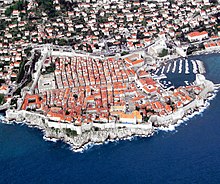 Most of the land area is covered by the Dinaric Alps mountain range running from north-west to south-east. The hills and mountains lie parallel to the coast, which gave rise to the geographic term Dalmatian concordant coastline. On the coasts the climate is Mediterranean, while further inland it is moderate Mediterranean. In the mountains, winters are frosty and snowy, while summers are hot and dry. To the south winters are milder. Over the centuries many forests have been cut down and replaced with bush and brush. There is evergreen vegetation on the coast. The soils are generally poor, except on the plains where areas with natural grass, fertile soils, and warm summers provide an opportunity for tillage. Elsewhere, land cultivation is mostly unsuccessful because of the mountains, hot summers, and poor soils, although olives and grapes flourish. Energy resources are scarce. Electricity is mainly produced by hydropower stations. The largest Dalmatian mountains are Dinara, Mosor, Svilaja, Biokovo, Moseć, Veliki Kozjak, and Mali Kozjak. The regional geographical unit of Dalmatia–the coastal region between Istria and the Bay of Kotor–includes the Orjen mountains with the highest peak in Montenegro, 1894 m. In present-day Dalmatia, the highest peak is Dinara (1913 m), which is not a coastal mountain, while the highest coastal Dinaric mountains are on Biokovo (Sv. Jure, 1762 m) and Velebit (Vaganski vrh, 1757 m),[78] although the Vaganski vrh itself is located in Lika-Senj County.[79] The largest Dalmatian islands are Brač, Korčula, Dugi Otok, Mljet, Vis, Hvar, Pag and Pašman. The major rivers are Zrmanja, Krka, Cetina, and Neretva. The Adriatic Sea's high water quality,[80] along with the immense number of coves, islands, and channels, makes Dalmatia an attractive place for nautical races, nautical tourism, and tourism in general. Dalmatia also includes several national parks that are tourist attractions: Paklenica karst river, Kornati archipelago, Krka river rapids, and the northwest of the island of Mljet. Administrative division
The area of Dalmatia roughly corresponds to Croatia's four southernmost counties, listed here north to south:[2]
Cities by populationOther large towns include Biograd, Kaštela, Sinj, Solin, Omiš, Knin, Metković, Makarska, Trogir, Ploče, and Imotski. Culture and ethnicity  The inhabitants of Dalmatia are culturally subdivided into two groups. The urban families of the coastal cities, commonly known as Fetivi,[85] are culturally akin to the inhabitants of the Dalmatian islands (known derogatorily as Boduli). The two are together distinct, in the Mediterranean aspects of their culture, from the more numerous inhabitants of the Hinterland. Referred to (sometimes derogatorily) as the Vlaji, their name originated from the Vlachs with whom they have no ethnic connection.[86][87] The former two groups (inhabitants of the islands and the cities) historically included many Venetian and Italian speakers, who are identificated as Dalmatian Italians. Their presence, relative to those identifying as Croats, decreased dramatically over the course of the 19th and the first half of the 20th century. Dalmatia, especially its maritime cities, once had a substantial local Italian-speaking population (Dalmatian Italians), making up 33% of the total population of Dalmatia in 1803,[88][89] but this was reduced to 20% in 1816.[90] Bartoli's evaluation was followed by other claims that Auguste de Marmont, the French Governor General of the Napoleonic Illyrian Provinces commissioned a census in 1809 which found that Dalmatian Italians comprised 29% of the total population of Dalmatia. In Dalmatia there was a constant decline in the Italian population, in a context of repression that also took on violent connotations.[91] During this period, Austrians carried out an aggressive anti-Italian policy through a forced Slavization of Dalmatia.[92] According to Austrian censuses, the Italian speakers in Dalmatia formed 12.5% of the population in 1865,[57] but this was reduced to 2.8% in 1910.[93] The Italian population in Dalmatia was concentrated in the major cities. In the city of Split in 1890 there were 1,969 Italians (12.5% of the population), in Zadar 7,423 (64.6%), in Šibenik 1,018 (14.5%) and in Dubrovnik 331 (4.6%).[94] In other Dalmatian localities, according to Austrian censuses, Italians experienced a sudden decrease: in the twenty years 1890-1910, in Rab they went from 225 to 151, in Vis from 352 to 92, in Pag from 787 to 23, completely disappearing in almost all the inland locations. Dalmatian identity, or sometimes also Dalmatianism, Dalmatianness or Dalmatian nationalism', refers to the historical nationalism or patriotism of Dalmatians and Dalmatian culture. There were significant Dalmatian nationalists in the 19th century, but Dalmatian regional nationalism faded in significance over time in favor of ethnic nationalism.[95] 17th century Dalmatian poet Jerolim Kavanjin (Girolamo Cavagnini) exhibited Dalmatianism, identifying himself as "Dalmatian" and calling Dalmatia his homeland, which John Fine interprets not to have been a nationalist notion.[96] During Dalmatia's incorporation in Austrian Empire, with the Autonomist Party in Dalmatia refusing and opposed plans to incorporate Dalmatia into Croatia; instead it supported an autonomous Dalmatia based on a multicultural association of Dalmatia's ethnic communities: Croats, Serbs, and Italians, united as Dalmatians.[97] The Autonomist Party has been accused of secretly having been a pro-Italian movement due to their defense of the rights of ethnic Italians in Dalmatia.[97] Also support for the autonomy of Dalmatia, had deep historic roots in identifying Dalmatian culture as linking Western culture via Venetian Italian influence and Eastern culture via South Slavic influence, such a view was supported by Dalmatian autonomist Stipan Ivičević.[98] The Autonomist Party did not claim to be an Italian movement, and indicated that it sympathized with a sense of heterogeneity amongst Dalmatians in opposition to ethnic nationalism.[97] In the 1861 elections, the Autonomists won twenty-seven seats in Dalmatia, while Dalmatia's Croatian nationalist movement, the People's Party, won only fourteen seats.[99] The issue of autonomy of Dalmatia was debated after the creation of Yugoslavia in 1918, due to divisions within Dalmatia over proposals of merging the region with the territories composing the former Kingdom of Croatia-Slavonia.[100] Proposals for the autonomy of Dalmatia within Yugoslavia were made by Dalmatians within the Yugoslav Partisans during World War II; however, these proposals were strongly opposed by Croatian Communists and the proposals were soon abandoned.[101] See also
References
Bibliography
External linksLook up Dalmatia in Wiktionary, the free dictionary.
|
||||||||||||||||||||||||||||||||||||||||||||||||||||||||||||||||||||||||||||||||||||||||||||||||||||||||||||||||||
Portal di Ensiklopedia Dunia



